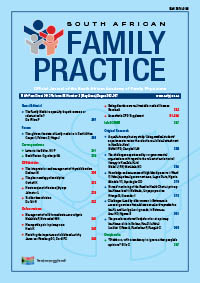The prevalence of erectile dysfunction at a primary healthcare clinic in Durban, KwaZulu-Natal
Keywords:
sexual dysfunction, prevalence, association with co morbid conditions, predictor of underlying conditions
Abstract
Objectives: The objectives of this study were to determine the prevalence of erectile dysfunction (ED) in men attending a primary healthcare (PHC) clinic in Durban, KwaZulu-Natal, and to document any relationship between ED and age, smoking, economic status and co-morbid conditions. Design: An observational, descriptive, cross-sectional study. Setting and subjects: More than 50% of men aged 40-70 years experience some degree of erectile dysfunction. However, no data is available on the prevalence of ED in a primary healthcare (PHC) setting in KwaZulu-Natal. Between February and March 2008, 1 300 questionnaires were distributed to men aged 18 years and older with no exclusion criteria, attending a general PHC clinic. Outcome measures: Responses were captured using a validated structured questionnaire (International Index of Erectile Function-15). Results: Eight hundred and three questionnaires were eligible for analysis. The overall prevalence rate of ED was 64.9% (621), of whom 14.6% (117) had mild ED, 19.9% (160) moderate ED, and 30.4% (244) severe ED. Erectile dysfunction increased with age, and there was a strong association between ED and economic status and co-morbid conditions. Conclusion: The prevalence of ED at this urban PHC clinic was high. Increased awareness by doctors working in the clinic may result in improved assessment and appropriate treatment that will enhance patients’ quality of life.
Published
2012-10-11
Section
Original Research
By submitting manuscripts to SAFP, authors of original articles are assigning copyright to the South African Academy of Family Physicians. Copyright of review articles are assigned to the Publisher, Medpharm Publications (Pty) Ltd, unless otherwise specified. Authors may use their own work after publication without written permission, provided they acknowledge the original source. Individuals and academic institutions may freely copy and distribute articles published in SAFP for educational and research purposes without obtaining permission.

